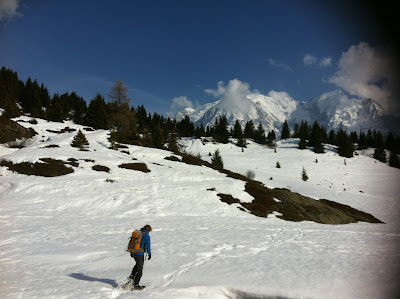It is true to say it has been a funny old season on this side of Mont Blanc in terms of snow (or the lack of it!) and many of the locals have seen one like it for many a year. Days of considerable snowfall can be counted on one hand, end of November, Christmas day, Boxing day, one day in Jan and one in Feb and thats about the extent of it (of course there has been a tad more at higher altitude). Saying all of that we can't grumble as we have had week on week of sunny skies and more recently summer temperatures. Although down the far end of the valley the Grand Montets is holding up well for skiers its becoming increasingly hard to find good quality snowshoe treks.
Half day snowshoe above Les Houches proved heavy going today, we took he Prarion lift gaining height quickly taking us above the snowline to 1850 mtrs. We took a short circular walk from the lift towards the summit of the Prarion at 1903 mtrs, the snow was heavy, waterlogged and proved hard going as is collapsed with every other step. However the great weather, temperatures of 15 degs and fabulous views made up for the difficult conditions under foot. Is this the last of the snow and last of the snowshoeing? it feels that way.... Looks like the Mont Blanc trekking season will start early this year.
Visit our website to find out more about what we do: www.montblanctreks.com


















